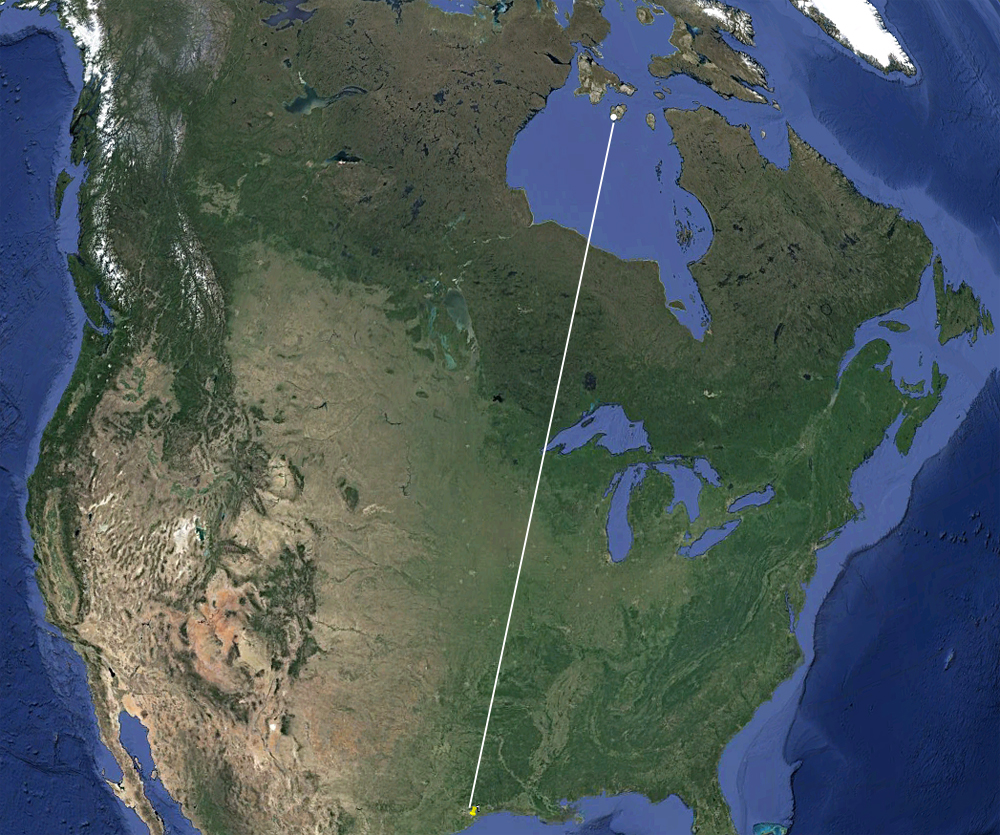 American Herring Gull (smithsonianus)
American Herring Gull (smithsonianus)
(last update: October 30, 2015)
American Herring Gull (smithsonianus) adult male R4 April 03 2000, La Marque, TX. Picture: Martin Reid.
Adult Herring Gull smithsonianus photographed at La Marque Grayhound Racetrack parking lot, Texas on April 3, 2000. The location is between Houston and Galveston. Color-banded, right leg: just above the foot was a metal band (data not discerned); still on the tarsus but just below the tarsus/tibia joint was an unmarked orangy-yellow band. Left leg: two bands on the tarsus resting above the foot; the lower band was unmarked green; the upper band was red with "R4" written sideways in white letters (repeated about 3 or 4 times). after correspondence, the band number appeared 966-30754.
This bird did not appear significantly different from the hundred-plus other adult HEGUs at the same site.

The bird was banded at an arctic field camp at East Bay, Southampton Island in Hudson Bay, Nunavut, Canada (61.4 N, 84.0 W) on June 21 1998. It was banded as part of a study on Herring Gulls by Karel Allard, a graduate student at the University of New Brunswick. Karel has been collecting information on the reproductive behaviour of Herring Gulls and predation of gulls on eider eggs and chicks. Karel has been at the field camp for several summers and will continue his observations in the 2000's.
Distance travelled: 2455 miles / 3942 KM. This is an exact match of the distance to Scotland!
A few interesting observations about this gull at the East Bay field site
from Karel:
Present 1999. Did not breed.
Present 2000. Did not breed. Paired with female H3 early, succeeded in
kicking unpaired "No Code" off site C, H3 and R4 both kicked off site C by
unbanded pair. H3 ended up pairing with other male and successfully hatched
young. "No Code" and R4 floated around for the rest of the 2000 season. A
film crew at the field camp last year captured a 25-30 minute fight on
film between R4 and "No Code" for site C.
Karel Allard responded by mail (March 28 2001):
"
I
witnessed a fierce battle for a nest site on the island colony (36 ha) with
another banded individual we call "No Code". The bird you photographed won
the battle and gained possession of a centrally located (good quality) nest
site and foraging territory. Here's the whole story...
R4 was captured using a cannon net (necessary to catch immature birds and
non-breeders) on June 21 1998 (sadly its plumage status was only recorded as
immature, suggesting alternate III). It did not breed in 1998.
R4 returned to the Island colony in 1999 in definitive alternate plumage but
did not breed. R4 foraged in the territories of others as a "floater".
Your observation: La Marque, Texas: April 3, 2000.
Arrival date East Bay, Southampton Island: May 30, 2000.
In 2000, male R4 and female H3 successfully took possession of a nest site and
territory from unpaired "No Code", occupied the site for a short period of
time until R4 lost a battle for the site with a paired unbanded male. The R4
and H3 pair subsequently dissolved and R4 reverted to the strategy of not
breeding and "floating" around the colony, intruding into the territories of
others to steal eggs, as it had done in previous years. "No Code" had also
adopted this "floater" strategy. R4 and "No Code" consequently both failed to
breed.
The island's 30 other territory-holding herring gull pairs have partitioned the eider colony into foraging territories containing numbers of eider nests. Because they can only take eggs from unattended eider nests, defended territories have to contain sufficient numbers of nests to ensure the likelihood of at least some being unattended.
I am interested in understanding how territories are established, how
hierarchies and possession of quality territories within the eider colony is
determined as well as the reason why certain birds (R4 and "No Code") choose
to float rather than attempt to breed elsewhere in the region (many do). Could they be waiting in line for a territory to become available? We'll
see...
This is the first confirmed resight record for herring gull from the Eastern
Arctic (and hopefully not the last!). We are looking into an other recent
potential East Bay resight record from New Jersey. Details to come.
Cheers and again, thanks!"
Karel Allard
And finally, here are Martin's images of the bird:




below: East Bay bird sanctuary on Southampton Island in Hudson Bay, Nunavut, Canada (61.4 N, 84.0 W).

below: Coral Harbour, entrance on Southampton Island in Hudson Bay, Nunavut, Canada (61.4 N, 84.0 W).
